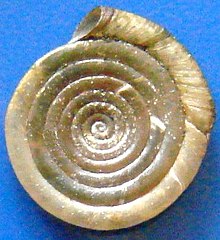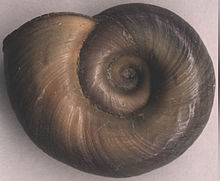Planorbidae: diferenças entre revisões
A iniciar tradução de https://en.wikipedia.org/w/index.php?title=Planorbidae&oldid=787524180 Etiqueta: Inserção de predefinição obsoleta |
(Sem diferenças)
|
Revisão das 09h15min de 4 de agosto de 2017
| Planorbidae | |
|---|---|

| |
| Exemplar vivo de Indoplanorbis exustus. | |
| Classificação científica | |
| Reino: | |
| Filo: | |
| Subdivisão: | Ver texto.
|
| Classe: | |
| (unranked): | |
| Superfamília: | |
| Família: | Planorbidae Rafinesque, 1815[1]
|
| Géneros | |
|
Ver texto. | |
| Diversidade[2] | |
| Cerca de 250 espécies de água doce. | |
Planorbidae é uma família de caracóis de água doce pulmonados pertencentes ao clade Panpulmonata dos Gastropoda.[2]
}}
|label2=Laevapecini
|2=
|
| |||||||
}}
|label2=new subfamily? "B-clade"
|2=
|
Glyptophysa sp. | |||||||||||||
| |||||||||||||
}}
|2=
| Camptoceratini? | |||||||||||||||||||||||||||||||||||||||||||
| Planorbinae |
| ||||||||||||||||||||||||||||||||||||||||||
| new subfamily? "C‑clade" |
| ||||||||||||||||||||||||||||||||||||||||||
}}
}}
}}
}}
Genera
The type genus of this family is Planorbis Müller. The following list of genera is organized according to the 2005 taxonomy, because Albrecht's 2007 taxonomy is not available for all genera of Planorbidae. Genera in the family Planorbidae include (subgenera listed according to Glöer (2002):[3]
- subfamily Planorbinae Rafinesque, 1815

- Anisus S. Studer, 1820
- subgenus Disculifer C. Boettger, 1944
- Bathyomphalus Charpentier, 1837
- Gyraulus Charpentier, 1837
- Hippeutis Charpentier, 1837
- Anisus S. Studer, 1820
- tribe Ancylini Rafinesque, 1815
- tribe Biomphalariini H. Watson, 1954
- Biomphalaria Preston, 1910 - type genus of tribe Biomphalariini[4]
- Drepanotrema Crosse & P. Fischer, 1880[4]
- tribe Planorbini Rafinesque, 1815
- tribe Planorbulini Pilsbry, 1934
- Planorbula Haldeman, 1840 - type genus of tribe Planorbulini[4]
- tribe Segmentinini F.C. Baker, 1945
- Segmentina Fleming, 1818 - type genus of tribe Segmentinini[4]
- subfamily Bulininae P. Fischer & Crosse, 1880
- Indoplanorbis Annandale & Prashad, 1920 - contains one species Indoplanorbis exustus[5]
- Planorbarius Duméril, 1806
- Planorbella Haldeman, 1842
- Menetus H. Adams & A. Adams, 1855
- subgenus Dilatata Clessin, 1885
- tribe Bulinini P. Fischer & Crosse, 1880
- Bulinus O. F. Müller, 1781 - type genus of subfamily Bulininae[4]
- Gundlachia Pfeiffer, 1849
- tribe Coretini Gray, 1847
- tribe Miratestini P. & F. Sarasin, 1897
- Miratesta P. & F. Sarasin, 1897 - type genus of tribe Miratestini[4]
- Amerianna Strand, 1928
- Ferrissia Walker, 1903[carece de fontes]
- Pettancyclus Iredale, 1943
- tribe Plesiophysini Bequaert & Clench, 1939
- Plesiophysa P. Fischer, 1883 - type genus of tribe Plesiophysini[4]
- subfamily Neoplanorbinae Hannibal, 1912
- Neoplanorbis Pilsbry, 1906 - type genus of subfamily Neoplanorbinae[4]
- subfamily Rhodacmeinae Walker, 1917
Subfamily = ? (other genera that are not yet sorted are listed here)
- Acrorbis Odhner, 1937
- Africanogyrus Özdikmen & Darilmaz, 2007
- synonym: Afrogyrus Brown & Mandahl-Barth, 1973 - Afroplanorbis Thiele, 1931
- Amphigyra Pilsbry, 1906
- Anisopsis Sandberger, 1875
- Antillorbis Harry & Hubendick, 1964
- Armigerus Clessin, 1884
- Australorbis Pilsbry, 1934
- Bayardella Burch, 1977
- Berellaia Laubrière & Carez, 1880
- Camptoceras Benson, 1843
- Camptoceratops Wenz, 1923
- Carinifex W.G. Binney, 1865
- Carinogyraulis Polinski, 1929
- Ceratophallus Brown & Mandahl-Barth, 1973
- Choanomphalus Gerstfeldt, 1859
- Culmenella Clench, 1927[6]
- Fossulorbis Pilsbry, 1934
- Glyptophysa Crosse, 1872
- Helicorbis Benson, 1855
- Helisoma Swainson, 1840
- Intha Annandale, 1922
- Isidorella Tate, 1896
- Kessneria Walker & Ponder, 2001
- Leichhardtia Walker, 1988
- Lentorbis Mandahl-Barth, 1954
- Macrophysa (Meek) Dall, 1870
- Paraplanorbis Hanna, 1922
- Patelloplanorbis Hubendick, 1957
- Pecosorbis D.W. Taylor, 1985
- Pentagoniostoma Branson, 1935
- Perrinilla Hannibal, 1912
- Physastra Tapparone-Canefri, 1883
- Physopsis Krauss, 1848
- Pingiella F.C. Baker, 1945
- Pitharella F. Edwards, 1860
- Planorbifex Pilsbry, 1935
- Planorbina Haldeman, 1842
- Platyphysa P. Fischer, 1883
- Platytaphius Pilsbry, 1924
- Polypylis Pilsbry, 1906
- Promenetus F.C. Baker, 1935
- Promenetus exacuous Henderson-Daniels, 1917 - Sharp sprite[7]
- Protancylus P. & F. Sarasin, 1897
- Pygmanisus Iredale, 1943
- Segmentorbis Mandahl-Barth, 1954
- Sineancylus Gutiérrez Gregoric, 2014
- Syrioplanorbis F.C. Baker, 1945
- Trochorbis Benson, 1855
- Vorticifex Meek in Dall, 1870
The genus Camptoceratops Wenz, 1923 is no longer considered to be a planorbid. It was recognised by Curry (1965, p. 360) as a euthecosomatous pteropod (Heterobranchia) (note by Arie W. Janssen, 092507).
The generic name Taphius H. Adams & A. Adams, 1855 is a synonym for Biomphalaria.[4]
Shell description

The shells of most species in this family are disk-like or button-like, being coiled in one plane, although several groups have shells that are more higher-spired, and some are limpet-like.
All coiled shell Planorbidae are sinistral in their shell coiling, as is proved by their internal anatomy (the respiratory and the genital orifice are situated on the left side), however the animals carry their shells with what would normally be the ventral (i.e. umbilical) surface uppermost, and because of this, the shells appear to be dextral.
Indeed, formerly planorbids were thought to have dextral shells, and so species of this family were figured as if they had dextral shells. Although it is now understood that these species are sinistral in shell coiling, disk-like Planorbid shells are often still shown in illustrations oriented as if they were dextral.
Most species of coiled planorbids have a rather thin and moderately smooth shell, although more distinct sculpture such as a keel occurs in, and is diagnostic of, certain species. In the flat, keeled species, the whorls tend to overlap.
The aperture has a sharp outer lip. A peristome can be present, but often the lip is not thickened nor reflected. Those planorbid species which have a high-spired shell may have a narrow umbilicus, but frequently this is covered by callus.
In height most species vary between 6 mm and 6 cm, however, disk-like shells are usually less than about 2 cm in maximum dimension.
Like all pulmonate aquatic snails, ramshorn shells do not have an operculum to close the shell aperture.
Sinistral shells



Flat-coiled planorbid gastropod shells are hard to understand in terms of their coiling and orientation. Many of the shells of species in this family are almost planispiral in coiling such that one side of the shell often looks rather like the other side, but it is important to bear in mind that nonetheless there is an umbilical side and a spire side of the shell. In addition these are in fact sinistral shells, despite the fact that the snail carries its shell as if it were a normal dextral shell. To make sense of the shell coiling, the following facts are useful:
- In life, these pond snails hold their shells upside down compared to the normal gastropod shell orientation, with the umbilicus facing upwards
- The spire of the shell is quite sunken in many species, in addition it is carried facing downwards
- The umbilicus of the shell is very wide and shallow
- In some species the umbilicus is not as deeply "dished" as the sunken spire is, so superficially it can be hard to tell one from the other
However, once it is understood that the planorbid shell is sinistral, if the shell is held with the aperture on the left and facing the observer, then the sunken spire side of the shell is uppermost. This is a convenience for understanding the shell, but is the opposite of the way the shell is actually carried in life.
The side of the shell which is in fact the spire (a sunken spire) faces down in the living animal, contrary to what is the case in almost all other shelled gastropods. Because the shell is carried "upside down" like this, the aperture of the shell is angled to face downwards also, so the aperture faces a little towards the spire, not away from it, as is usually the case in other shelled gastropods.
Blood pigment
Contrary to the case in most other molluscs, the blood of ram's-horn snails contains hemoglobin. As a result, these animals are able to breathe oxygen more efficiently than other molluscs. The presence of this substance gives the body a reddish colour. This is especially apparent in albino animals.
Habitat
Most species of planorbids live only in fresh water, such as ponds lake and slow moving rivers. A minority of species are able to survive in brackish water.
Geological history
Ancestors of ramshorn snails are known with certainty since the Jurassic period. Modern taxa developed since the Cretaceous.
Geographical distribution
Species in this family occur worldwide. In Northwest Europe about 20 species are known (including non-indigenous species). In this region, various extinct taxa are known to have occurred, starting in the Jurassic period.
>
Notas
- ↑ Rafinesque C. S. 1815. Analyse de la Nature ou tableau de l'univers et des corps organisés. Palermo, 223 pp., page 143.
- ↑ a b Strong E. E., Gargominy O., Ponder W. F. & Bouchet P. (2008). "Global Diversity of Gastropods (Gastropoda; Mollusca) in Freshwater". Hydrobiologia 595: 149-166. doi:10.1007/s10750-007-9012-6.
- ↑ (em alemão) Glöer P. 2002. Die Süßwassergastropoden Nord- und Mitteleuropas. Die Tierwelt Deutschlands, ConchBooks, Hackenheim, 326 pp., ISBN 3-925919-60-0, page 19-20.
- ↑ a b c d e f g h i j k l m Bouchet, Philippe; Rocroi, Jean-Pierre; Frýda, J; Hausdorf, B; Ponder, Winston; Valdés, Á; Warén, A. (2005). «Taxonomy of the Gastropoda (Bouchet & Rocroi, 2005) - Classification and nomenclator of gastropod families». Hackenheim, Alemanha: ConchBooks. Malacologia: International Journal of Malacology (em inglês). 47 (1-2): 1–397. ISBN 3925919724. ISSN 0076-2997
- ↑ Liu L et al. (2010) "The phylogeography of Indoplanorbis exustus (Gastropoda: Planorbidae) in Asia". Parasites & Vectors 3: 57. doi:10.1186/1756-3305-3-57.
- ↑ Mollusc Specialist Group (1996). Culmenella rezvoji. In: IUCN 2010. IUCN Red List of Threatened Species. Version 2010.4. <www.iucnredlist.org>. Downloaded on 08 March 2011.
- ↑ «Promenetus exacuous». Utah Division of Wildlife Resources. Consultado em May 19, 2017. Cópia arquivada em May 19, 2017 Verifique data em:
|acessodata=, |arquivodata=(ajuda)
Referências
- Gittenberger, E., Janssen, A.W., Kuijper, W.J., Kuiper, J.G.J., Meijer, T., Velde, G. van der & Vries, J.N. de (1998) De Nederlandse zoetwatermollusken. Recente en fossiele weekdieren uit zoet en brak water Nederlandse Fauna 2. Nationaal Natuurhistorisch Museum Naturalis, KNNV Uitgeverij & EIS-Nederland, Leiden, 288 pp.
- Fischer, P.H. (1880-1887) Manuel de Conchyliologie et de Paléontologie conchyliologique ou histoire naturelle des Mollusques vivants et fossiles suivi d'un appendice sur les Brachiopodes par D. Oehlert. – XXIV + 1369 pp.
- (German) Thiele, J. (1929-1935) Handbuch der Systematischen Weichtierkunde. Jena, (1), 1-376, 1929; (2), 377-778, 1931; 779-1022, 1934; 1023-1134, 1935.
- Vaught, K.C. (1989) A classification of living mollusca. American Malacologists Inc., Melbourne USA, ISBN 0-915826-22-4 & 0-915826-22-6, 195 pp.
- Wenz, W. (1923-1930) Gastropoda extramarina tertiaria. Fossilium Catalogus I. (4 vols.), 3387 pp.
- Zilch, A. (1959-1960) Euthyneura. In: H. Schindewolf (ed.), Handbuch der Paläozoologie, 6(2): pp. I-XII + 1-834.

